VOLVO XC90 TWIN ENGINE HYBRID 2017 Owner's Guide
Manufacturer: VOLVO, Model Year: 2017, Model line: XC90 TWIN ENGINE HYBRID, Model: VOLVO XC90 TWIN ENGINE HYBRID 2017Pages: 584, PDF Size: 14.2 MB
Page 31 of 584
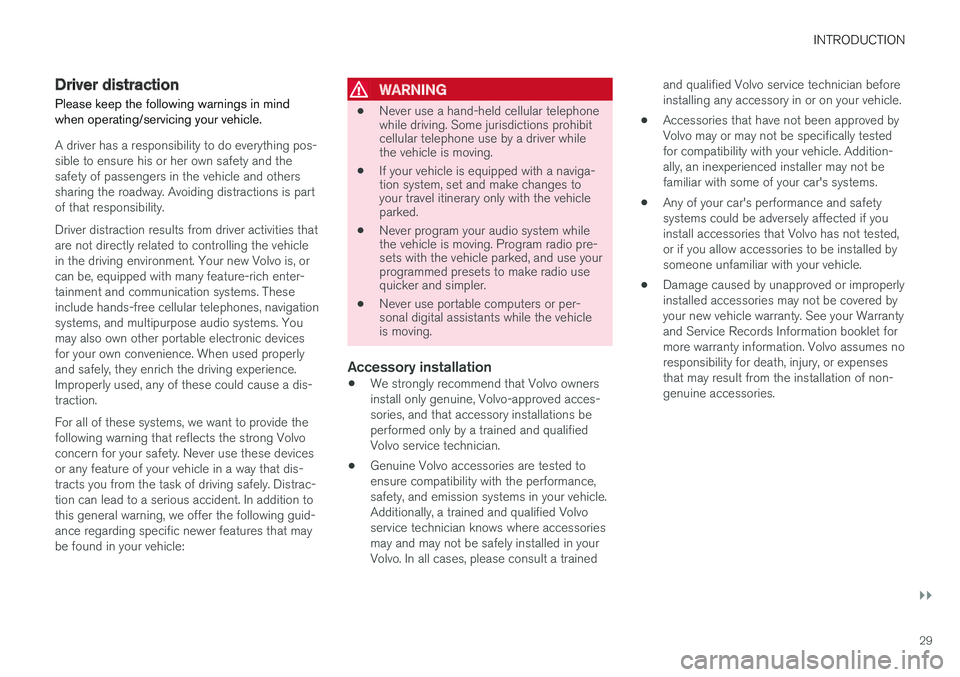
INTRODUCTION
}}
29
Driver distraction
Please keep the following warnings in mindwhen operating/servicing your vehicle.
A driver has a responsibility to do everything pos-sible to ensure his or her own safety and thesafety of passengers in the vehicle and otherssharing the roadway. Avoiding distractions is partof that responsibility.
Driver distraction results from driver activities thatare not directly related to controlling the vehiclein the driving environment. Your new Volvo is, orcan be, equipped with many feature-rich enter-tainment and communication systems. Theseinclude hands-free cellular telephones, navigationsystems, and multipurpose audio systems. Youmay also own other portable electronic devicesfor your own convenience. When used properlyand safely, they enrich the driving experience.Improperly used, any of these could cause a dis-traction.
For all of these systems, we want to provide thefollowing warning that reflects the strong Volvoconcern for your safety. Never use these devicesor any feature of your vehicle in a way that dis-tracts you from the task of driving safely. Distrac-tion can lead to a serious accident. In addition tothis general warning, we offer the following guid-ance regarding specific newer features that maybe found in your vehicle:
WARNING
•Never use a hand-held cellular telephonewhile driving. Some jurisdictions prohibitcellular telephone use by a driver whilethe vehicle is moving.
•If your vehicle is equipped with a naviga-tion system, set and make changes toyour travel itinerary only with the vehicleparked.
•Never program your audio system whilethe vehicle is moving. Program radio pre-sets with the vehicle parked, and use yourprogrammed presets to make radio usequicker and simpler.
•Never use portable computers or per-sonal digital assistants while the vehicleis moving.
Accessory installation
•We strongly recommend that Volvo ownersinstall only genuine, Volvo-approved acces-sories, and that accessory installations beperformed only by a trained and qualifiedVolvo service technician.
•Genuine Volvo accessories are tested toensure compatibility with the performance,safety, and emission systems in your vehicle.Additionally, a trained and qualified Volvoservice technician knows where accessoriesmay and may not be safely installed in yourVolvo. In all cases, please consult a trained
and qualified Volvo service technician beforeinstalling any accessory in or on your vehicle.
•Accessories that have not been approved byVolvo may or may not be specifically testedfor compatibility with your vehicle. Addition-ally, an inexperienced installer may not befamiliar with some of your car's systems.
•Any of your car's performance and safetysystems could be adversely affected if youinstall accessories that Volvo has not tested,or if you allow accessories to be installed bysomeone unfamiliar with your vehicle.
•Damage caused by unapproved or improperlyinstalled accessories may not be covered byyour new vehicle warranty. See your Warrantyand Service Records Information booklet formore warranty information. Volvo assumes noresponsibility for death, injury, or expensesthat may result from the installation of non-genuine accessories.
Page 32 of 584
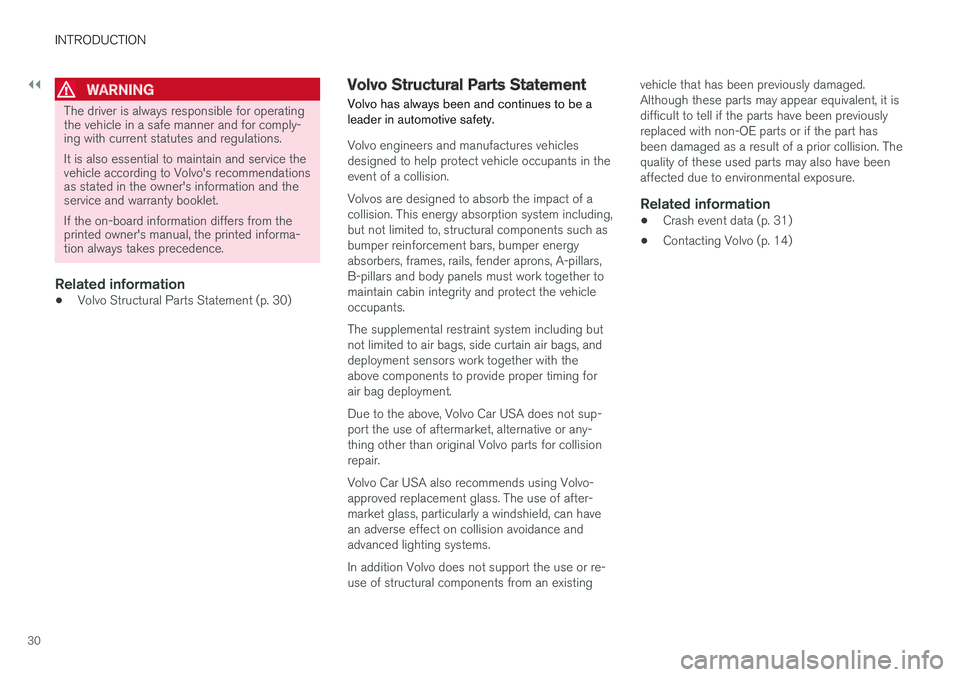
||
INTRODUCTION
30
WARNING
The driver is always responsible for operatingthe vehicle in a safe manner and for comply-ing with current statutes and regulations.
It is also essential to maintain and service thevehicle according to Volvo's recommendationsas stated in the owner's information and theservice and warranty booklet.
If the on-board information differs from theprinted owner's manual, the printed informa-tion always takes precedence.
Related information
•Volvo Structural Parts Statement (p. 30)
Volvo Structural Parts Statement
Volvo has always been and continues to be aleader in automotive safety.
Volvo engineers and manufactures vehiclesdesigned to help protect vehicle occupants in theevent of a collision.
Volvos are designed to absorb the impact of acollision. This energy absorption system including,but not limited to, structural components such asbumper reinforcement bars, bumper energyabsorbers, frames, rails, fender aprons, A-pillars,B-pillars and body panels must work together tomaintain cabin integrity and protect the vehicleoccupants.
The supplemental restraint system including butnot limited to air bags, side curtain air bags, anddeployment sensors work together with theabove components to provide proper timing forair bag deployment.
Due to the above, Volvo Car USA does not sup-port the use of aftermarket, alternative or any-thing other than original Volvo parts for collisionrepair.
Volvo Car USA also recommends using Volvo-approved replacement glass. The use of after-market glass, particularly a windshield, can havean adverse effect on collision avoidance andadvanced lighting systems.
In addition Volvo does not support the use or re-use of structural components from an existing
vehicle that has been previously damaged.Although these parts may appear equivalent, it isdifficult to tell if the parts have been previouslyreplaced with non-OE parts or if the part hasbeen damaged as a result of a prior collision. Thequality of these used parts may also have beenaffected due to environmental exposure.
Related information
•Crash event data (p. 31)
•Contacting Volvo (p. 14)
Page 33 of 584
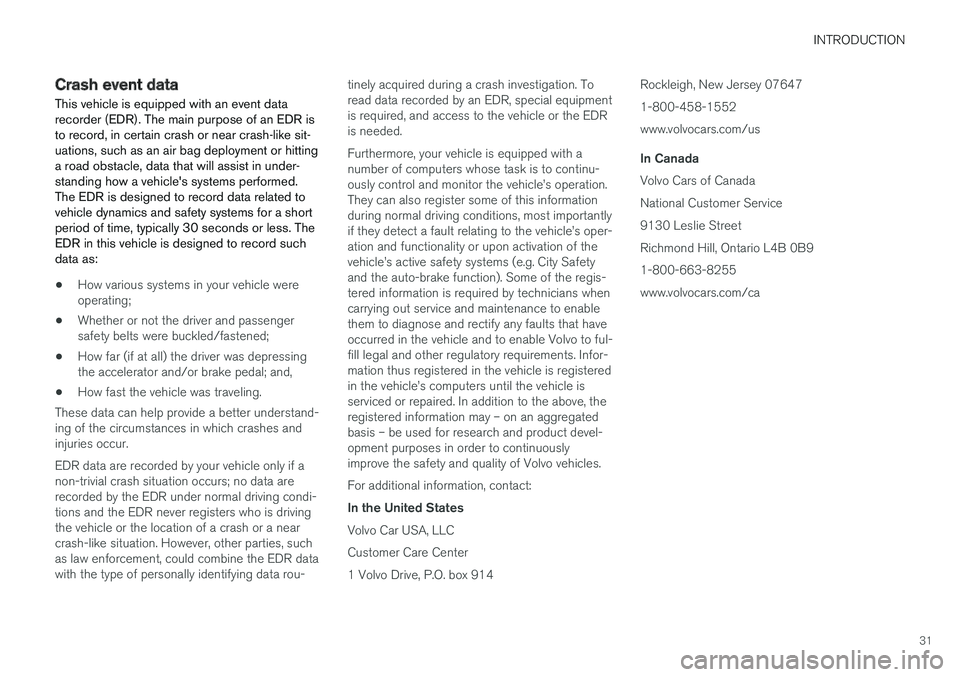
INTRODUCTION
31
Crash event data
This vehicle is equipped with an event datarecorder (EDR). The main purpose of an EDR isto record, in certain crash or near crash-like sit-uations, such as an air bag deployment or hittinga road obstacle, data that will assist in under-standing how a vehicle's systems performed.The EDR is designed to record data related tovehicle dynamics and safety systems for a shortperiod of time, typically 30 seconds or less. TheEDR in this vehicle is designed to record suchdata as:
•How various systems in your vehicle wereoperating;
•Whether or not the driver and passengersafety belts were buckled/fastened;
•How far (if at all) the driver was depressingthe accelerator and/or brake pedal; and,
•How fast the vehicle was traveling.
These data can help provide a better understand-ing of the circumstances in which crashes andinjuries occur.
EDR data are recorded by your vehicle only if anon-trivial crash situation occurs; no data arerecorded by the EDR under normal driving condi-tions and the EDR never registers who is drivingthe vehicle or the location of a crash or a nearcrash-like situation. However, other parties, suchas law enforcement, could combine the EDR datawith the type of personally identifying data rou-
tinely acquired during a crash investigation. Toread data recorded by an EDR, special equipmentis required, and access to the vehicle or the EDRis needed.
Furthermore, your vehicle is equipped with anumber of computers whose task is to continu-ously control and monitor the vehicle
Page 34 of 584
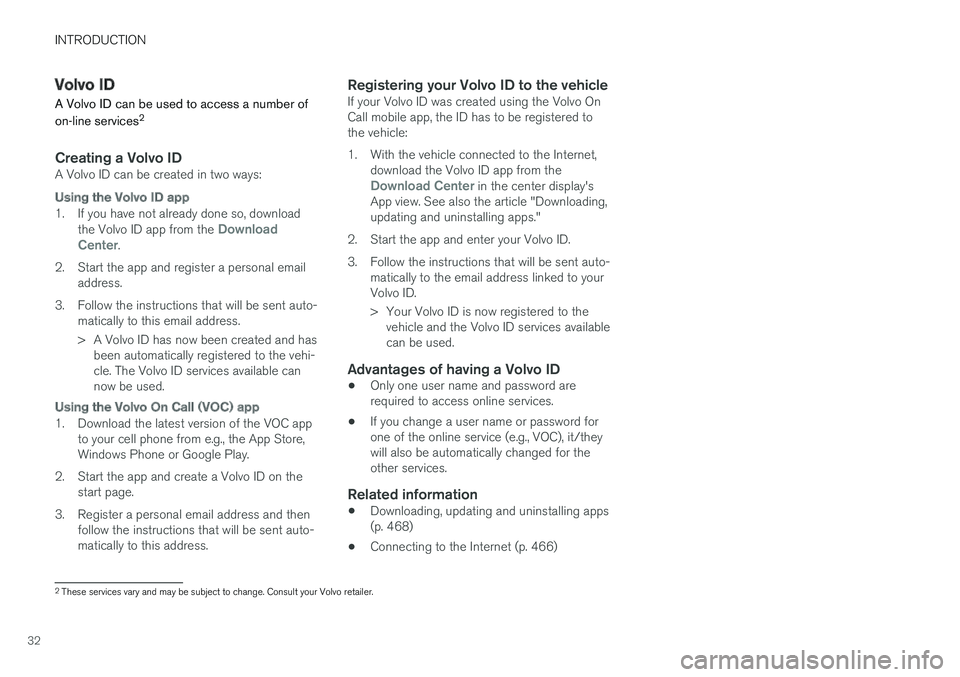
INTRODUCTION
32
Volvo ID
A Volvo ID can be used to access a number of
on-line services2
Creating a Volvo ID
A Volvo ID can be created in two ways:
Using the Volvo ID app
1. If you have not already done so, downloadthe Volvo ID app from the DownloadCenter.
2.Start the app and register a personal emailaddress.
3. Follow the instructions that will be sent auto-matically to this email address.
> A Volvo ID has now been created and hasbeen automatically registered to the vehi-cle. The Volvo ID services available cannow be used.
Using the Volvo On Call (VOC) app
1. Download the latest version of the VOC appto your cell phone from e.g., the App Store,Windows Phone or Google Play.
2. Start the app and create a Volvo ID on thestart page.
3. Register a personal email address and thenfollow the instructions that will be sent auto-matically to this address.
Registering your Volvo ID to the vehicle
If your Volvo ID was created using the Volvo OnCall mobile app, the ID has to be registered tothe vehicle:
1. With the vehicle connected to the Internet,download the Volvo ID app from theDownload Center in the center display'sApp view. See also the article "Downloading,updating and uninstalling apps."
2.Start the app and enter your Volvo ID.
3. Follow the instructions that will be sent auto-matically to the email address linked to yourVolvo ID.
> Your Volvo ID is now registered to thevehicle and the Volvo ID services availablecan be used.
Advantages of having a Volvo ID
•Only one user name and password arerequired to access online services.
•If you change a user name or password forone of the online service (e.g., VOC), it/theywill also be automatically changed for theother services.
Related information
•Downloading, updating and uninstalling apps(p. 468)
•Connecting to the Internet (p. 466)
2These services vary and may be subject to change. Consult your Volvo retailer.
Page 35 of 584
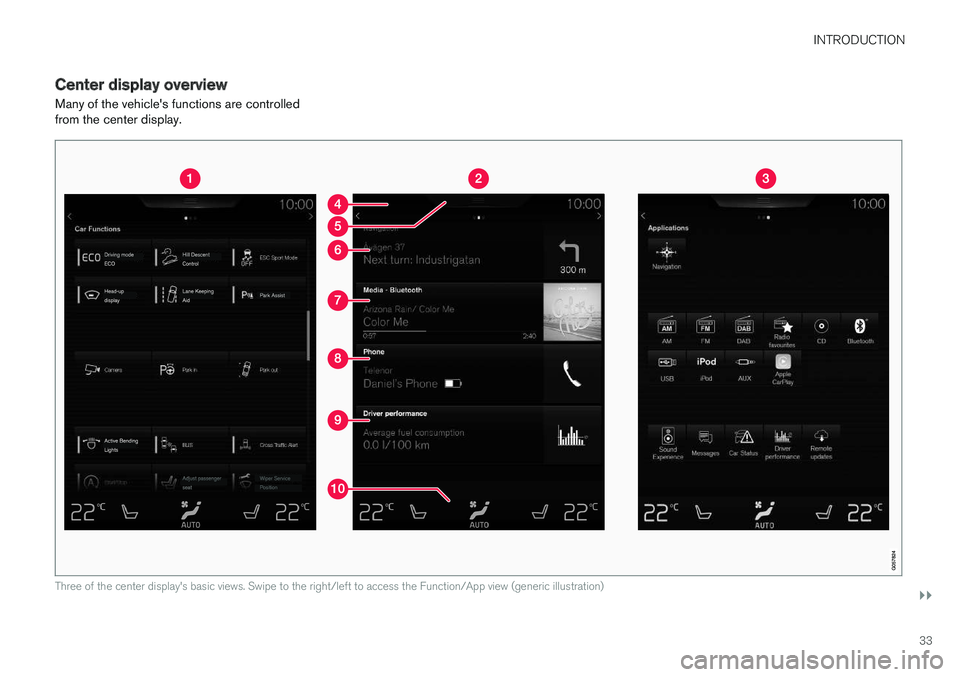
INTRODUCTION
}}
33
Center display overview
Many of the vehicle's functions are controlledfrom the center display.
Three of the center display's basic views. Swipe to the right/left to access the Function/App view (generic illustration)
Page 36 of 584
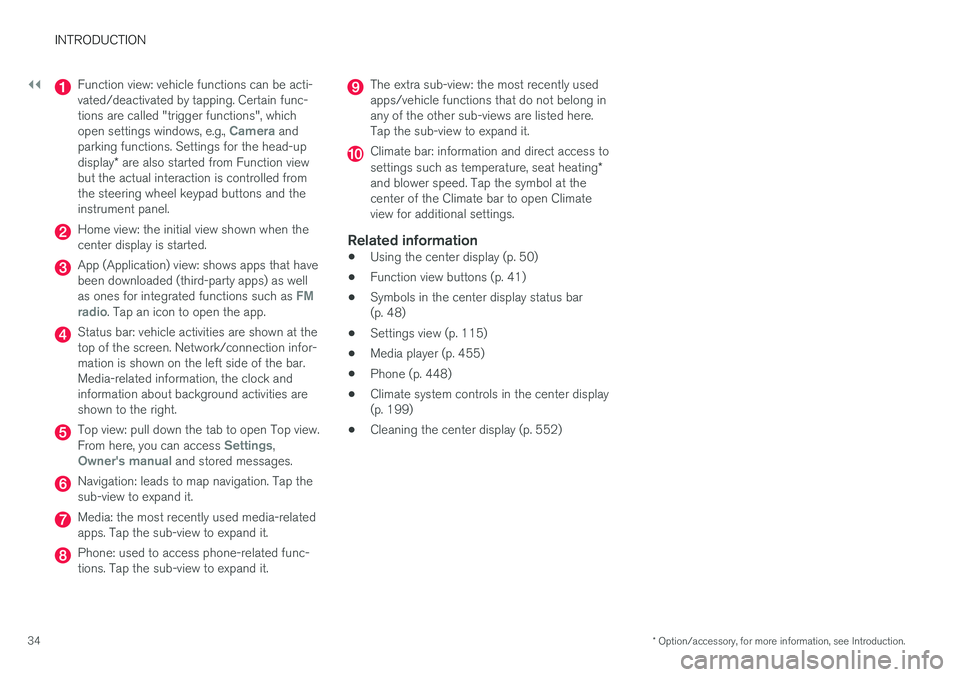
||
INTRODUCTION
* Option/accessory, for more information, see Introduction.34
Function view: vehicle functions can be acti-vated/deactivated by tapping. Certain func-tions are called "trigger functions", whichopen settings windows, e.g., Camera andparking functions. Settings for the head-updisplay* are also started from Function viewbut the actual interaction is controlled fromthe steering wheel keypad buttons and theinstrument panel.
Home view: the initial view shown when thecenter display is started.
App (Application) view: shows apps that havebeen downloaded (third-party apps) as wellas ones for integrated functions such as FMradio. Tap an icon to open the app.
Status bar: vehicle activities are shown at thetop of the screen. Network/connection infor-mation is shown on the left side of the bar.Media-related information, the clock andinformation about background activities areshown to the right.
Top view: pull down the tab to open Top view.From here, you can access Settings,Owner's manual and stored messages.
Navigation: leads to map navigation. Tap thesub-view to expand it.
Media: the most recently used media-relatedapps. Tap the sub-view to expand it.
Phone: used to access phone-related func-tions. Tap the sub-view to expand it.
The extra sub-view: the most recently usedapps/vehicle functions that do not belong inany of the other sub-views are listed here.Tap the sub-view to expand it.
Climate bar: information and direct access tosettings such as temperature, seat heating*and blower speed. Tap the symbol at thecenter of the Climate bar to open Climateview for additional settings.
Related information
•Using the center display (p. 50)
•Function view buttons (p. 41)
•Symbols in the center display status bar(p. 48)
•Settings view (p. 115)
•Media player (p. 455)
•Phone (p. 448)
•Climate system controls in the center display(p. 199)
•Cleaning the center display (p. 552)
Page 37 of 584
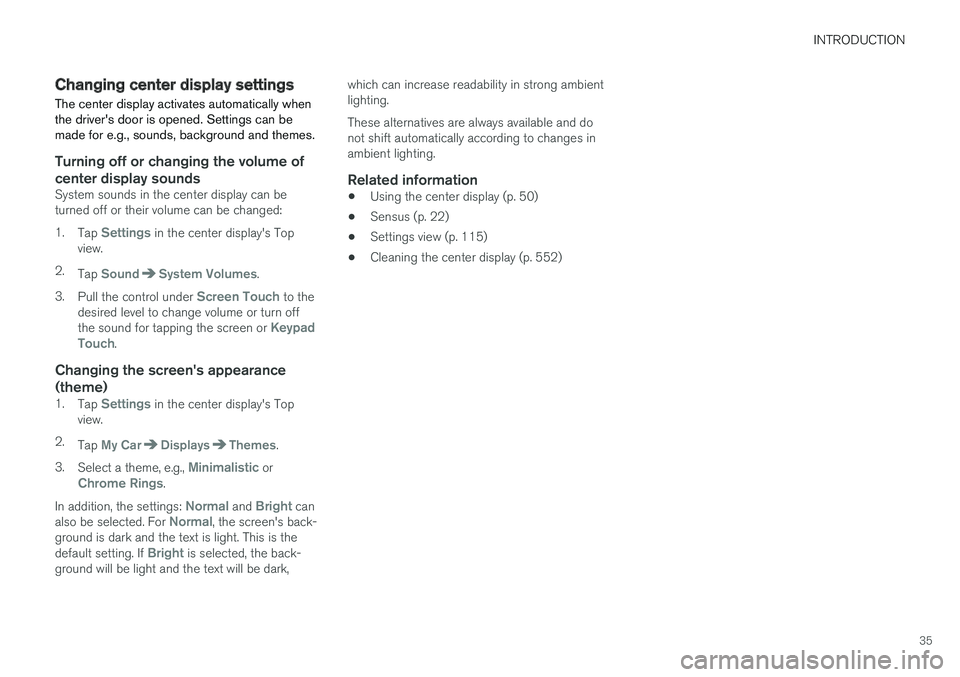
INTRODUCTION
35
Changing center display settings
The center display activates automatically whenthe driver's door is opened. Settings can bemade for e.g., sounds, background and themes.
Turning off or changing the volume of
center display sounds
System sounds in the center display can beturned off or their volume can be changed:
1.Tap Settings in the center display's Topview.
2.Tap SoundSystem Volumes.
3.Pull the control under Screen Touch to thedesired level to change volume or turn offthe sound for tapping the screen or KeypadTouch.
Changing the screen's appearance
(theme)
1.Tap Settings in the center display's Topview.
2.Tap My CarDisplaysThemes.
3.Select a theme, e.g., Minimalistic orChrome Rings.
In addition, the settings: Normal and Bright canalso be selected. For Normal, the screen's back-ground is dark and the text is light. This is thedefault setting. If Bright is selected, the back-ground will be light and the text will be dark,
which can increase readability in strong ambientlighting.
These alternatives are always available and donot shift automatically according to changes inambient lighting.
Related information
•Using the center display (p. 50)
•Sensus (p. 22)
•Settings view (p. 115)
•Cleaning the center display (p. 552)
Page 38 of 584
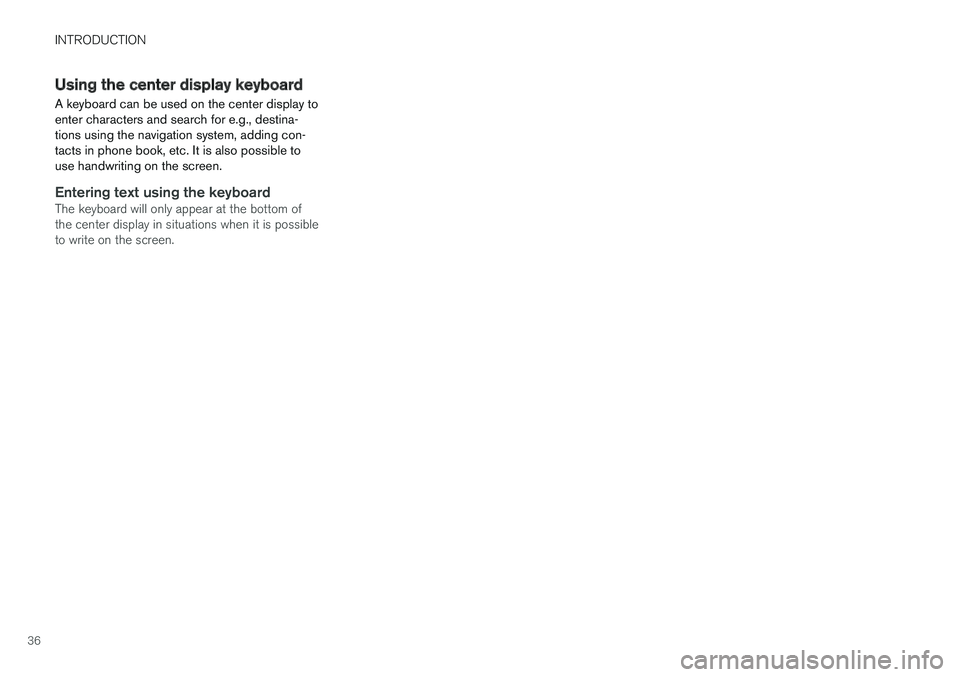
INTRODUCTION
36
Using the center display keyboard
A keyboard can be used on the center display toenter characters and search for e.g., destina-tions using the navigation system, adding con-tacts in phone book, etc. It is also possible touse handwriting on the screen.
Entering text using the keyboard
The keyboard will only appear at the bottom ofthe center display in situations when it is possibleto write on the screen.
Page 39 of 584
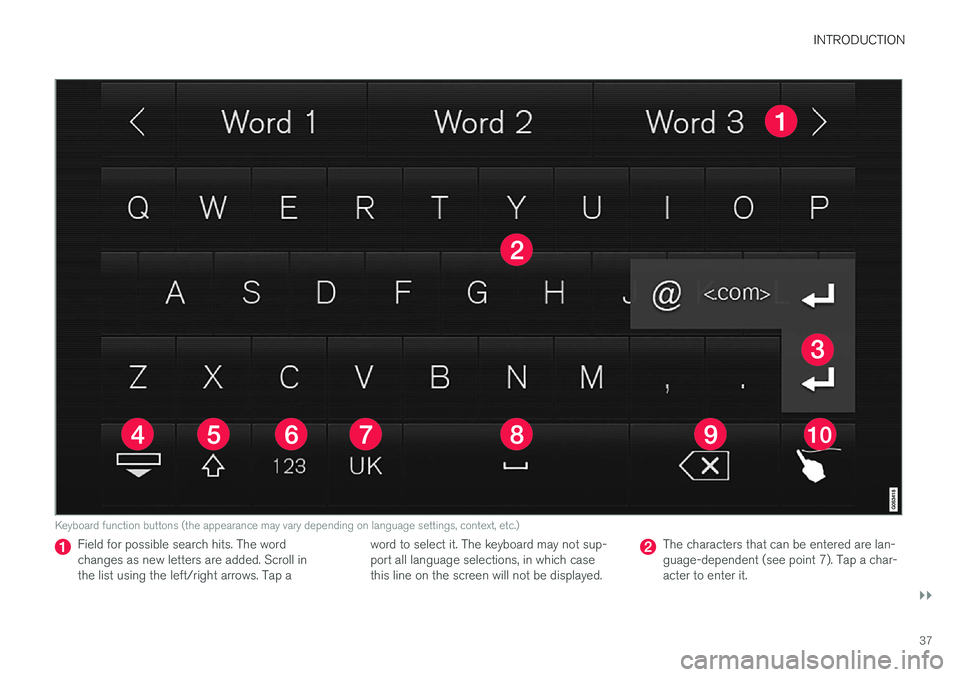
INTRODUCTION
}}
37
Keyboard function buttons (the appearance may vary depending on language settings, context, etc.)
Field for possible search hits. The wordchanges as new letters are added. Scroll inthe list using the left/right arrows. Tap a
word to select it. The keyboard may not sup-port all language selections, in which casethis line on the screen will not be displayed.
The characters that can be entered are lan-guage-dependent (see point 7). Tap a char-acter to enter it.
Page 40 of 584
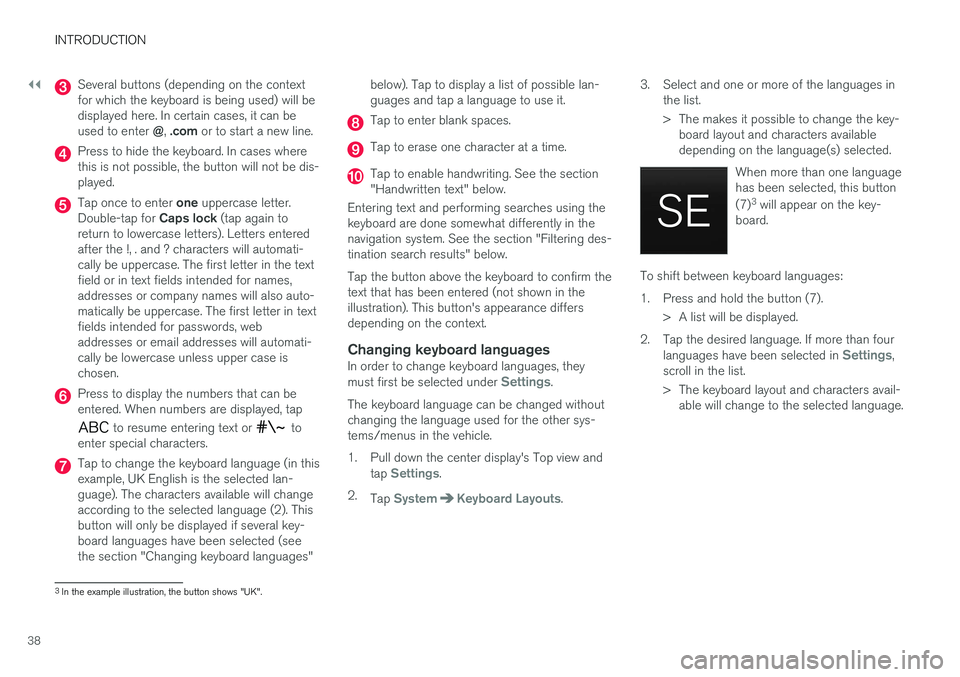
||
INTRODUCTION
38
Several buttons (depending on the contextfor which the keyboard is being used) will bedisplayed here. In certain cases, it can beused to enter @, .com or to start a new line.
Press to hide the keyboard. In cases wherethis is not possible, the button will not be dis-played.
Tap once to enter one uppercase letter.Double-tap for Caps lock (tap again toreturn to lowercase letters). Letters enteredafter the !, . and ? characters will automati-cally be uppercase. The first letter in the textfield or in text fields intended for names,addresses or company names will also auto-matically be uppercase. The first letter in textfields intended for passwords, webaddresses or email addresses will automati-cally be lowercase unless upper case ischosen.
Press to display the numbers that can beentered. When numbers are displayed, tap
to resume entering text or toenter special characters.
Tap to change the keyboard language (in thisexample, UK English is the selected lan-guage). The characters available will changeaccording to the selected language (2). Thisbutton will only be displayed if several key-board languages have been selected (seethe section "Changing keyboard languages"
below). Tap to display a list of possible lan-guages and tap a language to use it.
Tap to enter blank spaces.
Tap to erase one character at a time.
Tap to enable handwriting. See the section"Handwritten text" below.
Entering text and performing searches using thekeyboard are done somewhat differently in thenavigation system. See the section "Filtering des-tination search results" below.
Tap the button above the keyboard to confirm thetext that has been entered (not shown in theillustration). This button's appearance differsdepending on the context.
Changing keyboard languages
In order to change keyboard languages, theymust first be selected under Settings.
The keyboard language can be changed withoutchanging the language used for the other sys-tems/menus in the vehicle.
1.Pull down the center display's Top view andtap Settings.
2.Tap SystemKeyboard Layouts.
3. Select and one or more of the languages inthe list.
> The makes it possible to change the key-board layout and characters availabledepending on the language(s) selected.
When more than one languagehas been selected, this button
(7)3 will appear on the key-board.
To shift between keyboard languages:
1.Press and hold the button (7).
> A list will be displayed.
2. Tap the desired language. If more than fourlanguages have been selected in Settings,scroll in the list.
>The keyboard layout and characters avail-able will change to the selected language.
3In the example illustration, the button shows "UK".